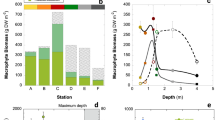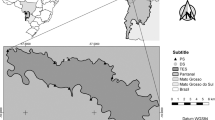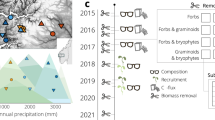Abstract
The equation w = Kd−3/2 (log10 w = log10 K − 1.5 log10 d) (1) defines a boundary condition known as the −3/2 power law1, above which combinations of mean plant weight and density may not occur. In this equation w is mean above-ground plant dry weight, d is plant density and K is a constant. For developing cohorts of plants combinations of mean weight and density approach and then move parallel to this boundary along lines for which log10 K is typically between 3.5 and 4.32. Annual shoot populations produced by clonal perennial herbs approach, but do not cross the line where log10 K = 4.3 (refs 3, 4). Dense, natural stands of many species with a wide range of growth forms and age distributions lie close to, but below the same line2,5. Virtually all plant populations for which data are available, therefore, fall below the line given by log10 w = 4.3 − 1.5 log10 d (2) We present here evidence suggesting that this line also defines a boundary condition for mean weight and density combinations in monospecific seaweed stands.
This is a preview of subscription content, access via your institution
Access options
Subscribe to this journal
Receive 51 print issues and online access
$199.00 per year
only $3.90 per issue
Buy this article
- Purchase on Springer Link
- Instant access to full article PDF
Prices may be subject to local taxes which are calculated during checkout
Similar content being viewed by others
References
Yoda, K., Kira, T., Ogawa, H. & Hozumi, K. J. Biol., Osaka City Univ. 14, 107–129 (1963).
White, J. in Demography and Evolution in Plant Populations (ed. Solbrig, O. T.) 21–48 (Blackwell, Oxford, 1980).
Mulchings, M. J. J. Ecol. 67, 21–33 (1979).
Mook, J. H. & Toorn, J. van der. J. appl. Ecol. 19, 501–517 (1982).
Gorham, E. Nature 279, 148–150 (1979).
Kays, S. & Harper, J. L. J. Ecol. 62, 97–105 (1974).
Fernandez, C. & Niell, F. X. Oecol. aquatica 5, 43–52 (1981).
Rice, E. L. & Chapman, A. R. O. Mar. Biol. (in the press).
Schiel, D. R. & Choat, J. H. Nature 285, 324–326 (1980).
Cousens, R. thesis, Dalhousie Univ. (1981).
Hutchings, M. J. & Budd, C. S. J. BioScience 31, 640–645 (1981).
Hutchings, M. J. & Budd, C. S. J. Oikos 36, 319–325 (1981).
Westoby, M. & Howell, J. J. Ecol. 69, 359–365 (1981).
Lonsdale, W. M. & Watkinson, A. R. New Phytol. 90, 431–445 (1982).
White, J. J. theor. Biol., 89, 475–500 (1981).
Westoby, M. Am. Nat. 118, 581–587 (1981).
Cousens, R. Botanica mar. 25, 191–195 (1982).
White, J. & Harper, J. L. J. Ecol. 58, 467–486 (1970).
Author information
Authors and Affiliations
Rights and permissions
About this article
Cite this article
Cousens, R., Hutchings, M. The relationship between density and mean frond weight in monospecific seaweed stands. Nature 301, 240–241 (1983). https://doi.org/10.1038/301240a0
Received:
Accepted:
Issue Date:
DOI: https://doi.org/10.1038/301240a0
This article is cited by
-
A meta-analysis shows that seaweeds surpass plants, setting life-on-Earth’s limit for biomass packing
BMC Ecology (2019)
-
The biomass–density relationship in seagrasses and its use as an ecological indicator
BMC Ecology (2018)
-
Interactions of Algae within the Community of Gracilaria gracilis (Rhodophyta)
Russian Journal of Marine Biology (2005)
-
The relationship between stand biomass and frond density in the clonal alga Mazzaella cornucopiae (Rhodophyta, Gigartinaceae)
Hydrobiologia (1996)
-
Impact of phosphorus loadings on macro-algal communities in the Red Sea coast of Egypt
Water, Air, & Soil Pollution (1995)
Comments
By submitting a comment you agree to abide by our Terms and Community Guidelines. If you find something abusive or that does not comply with our terms or guidelines please flag it as inappropriate.



